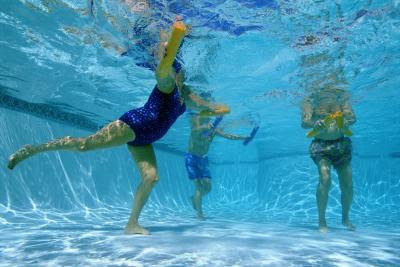Water aerobics provides a low-impact alternative to traditional aerobic
routines, placing less stress on joints and muscles than a comparable
workout on dry land. On the website Pool Life, certified aquatic
exercise instructor MaryBeth Pappas Baun says that a person's body
weight in a pool is effectively reduced 90 percent thanks to their
buoyancy in water, allowing participants to exercise with fewer physical
jolts. Make calf stretches part of your warm-up to help prepare you for
the physical demands of your routine and promote your development of proper balance in chest-deep water.

If
you experience problems with your range of motion due to weakness in
your limbs, you'll find that your buoyancy within the pool adds support
that allows you to extend your arms and legs more fully without
discomfort. Exercising in chest-deep water also provides support for
your lower back and spine, which may allow you to perform aerobic
exercises within the pool that would be excessively painful on land. The
water's viscosity adds a greater measure of resistance than you'd
experience outside the pool, and your exertion against the water will
help strengthen and tone your calf muscles during your stretches.


Water aerobics is a moderate-intensity activity that burns 145 to 380
calories in 30 minutes, depending on your weight and how hard you
exercise, according to FitnessforWeightLoss.com. If you weight 150
pounds, for example, you will burn about 145 calories while a 250-pound
person will burn about 240 calories per half hour. While you might be
able to lose weight faster by swimming laps, which is a more intense
exercise, water aerobics may appeal to you more if you prefer group
exercise, dislike putting your face in the water, or lack swimming
skills.
Prepare your body for
exercising by warming up. The instructor will lead you through a warm up
sequence but you can warm up before class by water jogging and
stretching.
Keep moving between exercises
to maximize calorie burn. Perform scissor kick or jumping jacks, tread
water, do lunges or move your arms rapidly through the water in front of
you and in back of you.
Increase your heart rate and
burn more calories by raising the intensity of the exercise. Make your
movements larger, move from one side of the pool to the other and back,
and move more quickly to increase the amount of resistance on your body,
Increase the resistance of the
water against your body and the intensity of the exercise by using a
foam noodle, water dumbbells, ankle cuffs or webbed paddles, suggests
Baun. Substitute household items such as empty plastic milk containers
for dumbbells and plastic frisbees for paddles if you prefer not to
purchase equipment.
Ask your instructor to suggest ways to increase the intensity of your workout when the routine becomes too easy for you.
- To
lose 1 pound per week, you need to create a 3,500-calorie deficit
between the number of calories you consume and the number you burn,
according to the Centers for Disease Control and Prevention. You can
create the deficit by burning 500 more calories a day through exercise,
by reducing your normal calorie intake by 500 each day, or by combining
the two approaches.
- If
the class is held in an outdoor swimming pool, wear sunscreen and a hat
to minimize sun exposure.
Wear aqua shoes or an old pair of tennis shoes to prevent you from
slipping on the bottom of the pool when exercising in shallow or
chest-high water.
- SO WHAT U WAITING FOR TAKE A ACTION :)!





Geen opmerkingen:
Een reactie posten